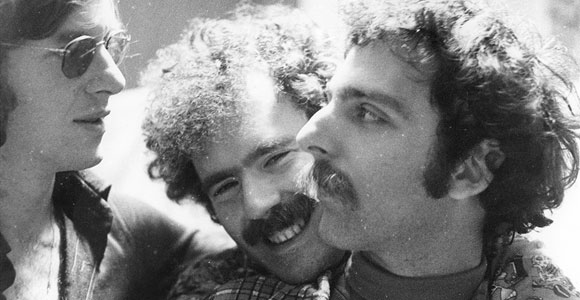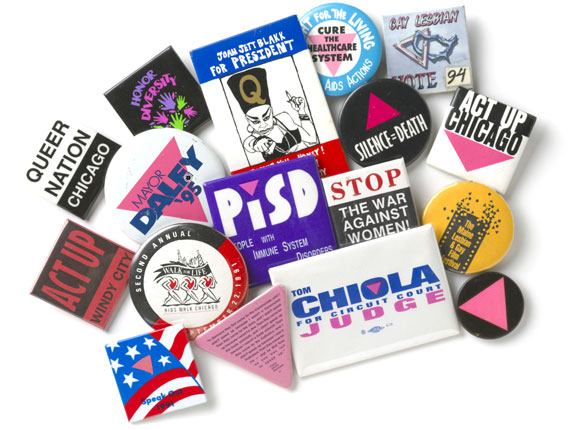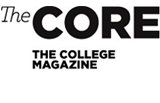
Desire for history
A College class uncovers the history of gay and lesbian student life.
Elizabeth Station
What was it like for gay students when you were [at the U of C]?
There was nothing, nothing, nothing. There was one dance—you had to be so courageous to go to that dance—I mean, to walk into that room, and everybody knew that was going to be the first gay dance. It was really scary. It was horrible. There were about four women. There was a gay bar called the Cove. And that was it.
—Novelist and playwright Sarah Schulman, X’79, in a 1993 interview with the Maroon’s Grey City JournalIWe are excited to welcome you to campus! The University of Chicago has long been a place where queer students and allies have thrived. Here you will find a diverse and vibrant LGBTQA community. …
We’ve got everything you need here to adjust to queer life on campus and in the City of Chicago. Whether you’re looking for a student organization to get involved in, or need help navi“gay”ting Chicago, this website will provide the resources you need. Don’t forget to attend one of our orientation events and make new friends and meet queer and queer-friendly community members.
—Website of the University’s Office of Lesbian, Gay, Bisexual, Transgender, and Queer (LGBTQ) Student Life, 2012
If the title of the course wasn’t bold enough to draw students’ attention, its ambitions were. Offered this past spring quarter, Queer on the Quads: Uncovering LGBTQ History at the University of Chicago aimed—according to the syllabus—to introduce undergraduates “to the practice, theory, and interpretation of oral history as a primary source in studying the history of gender and sexuality in the 20th century US.”
Meeting twice a week in the library’s Special Collections Research Center, the class discussed readings and explored sources in the University archives. Instructor Monica Mercado, AM’06, a doctoral candidate in history, also prepared students to conduct oral-history interviews with alumni and staff. It was the first step toward building an archive to document the lesbian, gay, bisexual, transgender, and queer (LGBTQ) experience at the University.
The course was cross listed in history and gender studies, but only a handful of the 18 students came from those majors. Most enrolled because “this history is intensely personal or personally interesting,” says Mercado.
Sonia Gonzalez, AB’12, a sociology major and “ally” to her gay and lesbian friends, took the class because “I wanted to know more about the history of the school that is now my alma mater.” Connor Gilroy, now a fourth-year in biology and geophysical sciences, had never taken a gender-studies course. But he is active in the student group Queers and Associates and hoped to learn more about its origins.
Readings and guest speakers put the evolution of campus gay and lesbian life into a broader historical context, showing, for example, how the social upheavals of the Second World War helped create gay communities in cities across America. “The 1940s were much more open than I would have thought, … and the ’50s weren’t uniformly bad and terrible for everyone,” says Gilroy. “One thing the class did very well was shake up notions of progress—like LGBTQ life sucked, and then [the 1969] Stonewall [riots] happened and things started to get better.”
At the University of Chicago, progress had its own complicated path.
Community history
In the tumultuous 1960s, Allan Bérubé, X’68, had a full scholarship to the College but left school just weeks before graduation. He told the story in an essay about his working-class childhood in My Desire for History (2011). Less privileged students, he argued, made a bargain with universities to work hard in exchange for financial support and eventual career success:
“But in 1968, during my senior year, I dropped out of college. A crisis hit me in April as I started to confront my homosexuality before gay liberation, faced class panic when I was rejected for graduate school and didn’t know what came next, feared for my own life as I witnessed murders on the streets during the Chicago riots following the assassination of Dr. Martin Luther King Jr., and decided to resist the draft rather than fight in Vietnam. The world was coming apart around me, yet I blamed myself for not working hard enough to keep up my part of the bargain.”
A self-taught “community historian,” Bérubé never earned a degree but became a pioneer in the field of gay history. He shared his early work with gay and lesbian audiences in public talks and traveling slide shows—sometimes charging admission to help fund his research—and in alternative publications such as the Gay Community News and the Advocate.
Bérubé won a Lambda Literary Award for Coming Out Under Fire (1990), a national history of gay and lesbian soldiers who served in the Second World War. The book was made into a 1994 documentary and Bérubé received a MacArthur “genius” fellowship in 1996. He once told a friend that historical work gave him the chance to “use the skills I learned in college … in an unalienated way.”
More broadly, Bérubé saw history as a tool for change and believed that people who knew their stories—whether about lesbians who passed as men in 19th-century San Francisco or gay soldiers forced to leave the military with “blue discharges”—could be moved to political activism.
Assigned for Queer on the Quads and published posthumously, My Desire for History gathers Bérubé’s early writings with excerpts from a book project on the racially diverse and “queer friendly” Marine Cooks and Stewards Union. The project merged his interests in gay, community, and labor history but was never finished. Bérubé died unexpectedly from ruptured stomach ulcers in 2007. He was 61.
The legacy of gay liberation
Alumni who remember “nothing, nothing, nothing” for gay and lesbian students haven’t talked to David Goldman, AB’72. “I was very active in the Gay Liberation group that we started on the campus in 1970,” he says. “It was the first gay student group at the University of Chicago, and one of the first on any college campus in the country.”
One of very few openly gay students in the College, Goldman says, “I was out of the closet while living in Henderson House in Pierce Tower. Most people were pretty tolerant. There were a few isolated examples of hostility—I had a Gay Liberation poster on my dorm door, and one day I came home and there were cigarette burns all over it.”
Goldman’s friend and fellow activist Kevin Burke, AB’72, PhD’99, recalls Gay Liberation as a radical political organization whose members weren’t afraid to push publicly for change. In late 1971 the group heckled a speech by Chicago Seven prosecutor Thomas Foran at the Quad Club. Police forcibly removed the students and beat and arrested four, including Burke, whose identification they inspected at the police station. “I have an Irish Catholic name and the others didn’t,” he remembers. “They said, ‘What’s a nice Irish kid like you doing with these faggot Jew commies?’”
Gay Liberation successfully pressed the University administration for the right to establish a drop-in center in Ida Noyes Hall and to host public, same-sex dances on campus. One of the first dances drew 600 people to Pierce Tower in 1970, a detail that delighted Matthew Krisiloff, now a third-year student. (“My dorm—the dance must have taken place in the dining hall I eat in every day!” he wrote in a footnote to his paper for Queer on the Quads.)
Along with these triumphs came episodes of discrimination and loss—historical events, rather than lived experiences, for most undergraduates born in the 1990s. Mercado sent the class to see Court Theatre’s 2012 revival of Angels in America to learn about the early years of the AIDS epidemic. The students read newspaper accounts of antigay harassment on campus and the protests that ensued.
Today, seven different student organizations and the Office of LGBTQ Student Life—housed in spacious quarters at 5710 South Woodlawn—offer support, social events, and professional opportunities. Over the past century, Krisiloff wrote, the University has slowly evolved “from treating homosexuals as an academic curiosity, to treating queers with intolerance, and finally to embracing and accepting LGBT identifying people.”
Queer studies and oral history
Do oral histories provide reliable representations of the past? … Does the history of sex, sexuality, and desire have a unique relationship to self-disclosure and, thus, to oral history methods? … And is there something voyeuristically compelling about the way narrators (and researchers) create social meaning out of sexual desire?—Nan Alamilla Boyd, “Who Is the Subject? Queer Theory Meets Oral History” (2008)
George Chauncey taught at the University of Chicago from 1991 to 2006 and authored Gay New York (1994), a book that helped launch the field of LGBTQ history. Because archival sources were scarce, he wrote, “early in my research it became clear that oral histories would be the single most important source of evidence concerning the internal working of the gay world.”
Over three decades, the academic field of queer studies has developed its own research questions, methods, and jargon. Archival collections exist, but oral history remains a crucial tool for constructing narratives of events and experiences. At the same time, both novices and seasoned researchers struggle with the method’s limitations—not only does oral history rely on the narrator’s memory, but when talking about sexuality much may be omitted or changed.
Students in Mercado’s class learned interviewing techniques by practicing on each other. Paired with a classmate, each asked the other why they had chosen the College and the class. But when second-year Danielle Wilson interviewed Zach Price, AB’12, she says they both avoided questions that seemed taboo or invasive: “He mentioned coming out on his own. I wasn’t going to ask about that. He didn’t ask me about my sexuality.” (Even during the week that the syllabus dubbed “Let’s Talk About Sex,” she adds, students avoided the subject.)
As the quarter progressed, the class got methodological guidance from Bodies of Evidence: The Practice of Queer Oral History (2012), essays by scholars who had interviewed LGBTQ narrators about silence, sex, friendship, and politics. By May, students zeroed in on topics for their final papers and picked from a list of 20 volunteers—mostly University alumni and staff—who agreed to be interviewed.
Everyone was a little anxious. For her BA project in sociology, Sonia Gonzalez had conducted 100 interviews in Chicago’s Lawndale neighborhood, knocking on strangers’ doors to ask them about a nearby charter school. But she felt nervous preparing for her oral-history interview with Madelyn Detloff, AB’87, an associate professor of English and women’s, gender, and sexuality studies at Miami University of Ohio.
“The issues are so close to home and the subjects are very personal, so I was internally freaking out, just figuring out what she would be prepared to tell me,” admits Gonzalez. She drafted three pages of questions, anticipating every direction their telephone conversation might take.
In the end, Gonzalez says, she didn’t have to ask Detloff much: “She had definitely given this some thought and knew what she wanted to talk about.” Detloff chuckled as she shared her coming-out story, which took place during her first year in the College. Soon she and Gonzalez were both laughing about the awkwardness of many students, including themselves. “For a lot of UChicago kids, in particular, this is your first real interaction with sex and exploring sexuality,” explains Gonzalez. “Huge generalization here, but a lot of folks aren’t that active in high school because we’re very nerdy.”

If there’s not an archive, is there a history?
Two questions riveted Mercado’s students: Where does history come from, and how can it become history if we don’t collect or save it? “Particularly for LGBT history, there are some archives, but they’re not deep,” she says.
Special Collections houses an intriguing and eclectic set of primary sources: notes on homosexual life in the city of Chicago, gathered by graduate students doing urban-sociology research during the 1920s and ’30s. Gay and lesbian pulp novels, with titles like Dormitory Women and When Men Meet, in the library’s popular literature collection. Clippings from the Maroon that document antigay episodes on campus in the late 1980s and early ’90s. There are fliers and a torn sheet of paper listing chants that student protesters presumably delivered to administrators (“Harassment is violence/Can’t fight it with silence”).
Viewed in isolation, such sources are interesting but don’t tell a coherent story. UChicago librarians are “very aware and very open about the fact that they don’t have a lot to document student life,” says Mercado.
In 2009 she helped curate an exhibition, On Equal Terms, chronicling women’s experiences at the University with archival materials and oral histories. The project’s success prompted the Center for the Study of Gender and Sexuality to sponsor the LGBTQ history course and begin collecting oral histories and archival contributions from interested alumni, faculty, and staff. They hope to interview 75 people in the next two years.
Two students from Mercado’s class, Ashley Mayo and Kelsey Ganser, have been hired as paid interns for the project. About 50 people already have agreed to give interviews—including David Goldman, who will donate his copy of the University’s 1971 student handbook to the project. He’s saved it all these years because it may contain the first description of a gay student organization in an official campus publication.
“It was a wonderful memento and artifact that I really treasure looking at,” he says. “I think it belongs in the archives. In my closet, it doesn’t do anyone any good.”
Learn more about the Center for the Study of Gender and Sexuality’s project, Closeted/Out in the Quadrangles: A History of LGBTQ Life at the University of Chicago.
